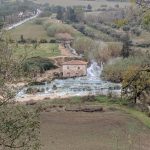Pompeii -Learning Before I Go
Mom and Dad asked me to read about Pompeii before we go. Here is a short paper I wrote. Watch for my Pompeii blog in the next day or two.
~
The Pompeii eruption was not the first large eruption to hit Mount Vesuvius. In fact, it was not even the largest. In around 1780 B.C. there was an eruption named the Avellino eruption. This eruption propelled millions of tons of ash and other material 22 miles into the sky. For comparison, space is said to start at around 19 miles.
In 63 A.D. a large earthquake believed to be a 5-6 on the Richter scale struck the region causing considerable damage to many of the surrounding cities. Many people fled the area for safer places and while the cities were mostly repaired the citizens didn’t know that this was a sign of the massive devastation to come. To this day some of the old damage can still be seen in the ruins. Many people soon forgot the damage as the area was a huge trading outpost and very popular place to live. It was effectively the Hawaii of ancient Rome.
The streets where littered with shops and extensive villas filled with frescos and other beautiful art. At the time the city was a bustling port city. This was the place where the most wealthy and powerful lived. The land was very good for farming due to the volcanic ash from previous eruptions that the land could produce double the wine that many other places in Italy could in the same amount of land.
Somewhere between June and November 79 A.D. The mountain erupted in what was described by the writer Pliny the Younger as, “An unusual pine tree shaped cloud that rose to a great height before splitting off into many branches.” In honor of this early writing geologists now refer to this type of eruption as a Plinian eruption. His uncle Pliny the Elder was an admiral in the Roman naval fleet stationed across the bay in Naples. He ordered his fleet across the bay in an attempt to save some civilians but he perished in the attempt. As the debris in the air started to cool, the volcano spit out more and more debris. Ash started to rain down on Pompeii and waves of superheated gas went through the city killing everyone on sight in a matter of minutes no matter if they were inside or not. As ash continued to fall over the next 6 hours it rose to a staggering height of 82 feet covering everything down below.
Over the years, Pompeii was mostly forgotten and the buried bodies began to decay. Then almost 1500 years later the ancient city was rediscovered. Finally, 300 years later in about 1800 large archaeological digs began and the city began to be uncovered. As the city was dug out large cavities were found and some of these were filled with plaster. Then the plaster was dug out giving often very gruesome images of what some of the citizens last moments were like. Artifacts were found with the molds. These were often metals like coins and rings.
Now Pompeii is a UNESCO world heritage site and draws over 2.5 million visitors each year. The ruins give us a great insight into the way that Roman life worked. The eruption has been dated to around Mid-September to Early November because of a coin found in one of the cavities that was minted no earlier than the second week of September. Pompeii is a treasure that should be cherished by many generations to come.
https://www.history.com/topics/ancient-history/pompeii
https://en.wikipedia.org/wiki/Pompeii
 Previous Post
Previous Post Next Post
Next Post
Would you have liked to have been one of the people to dig up the ancient site? Making these discoveries must have been amazing.